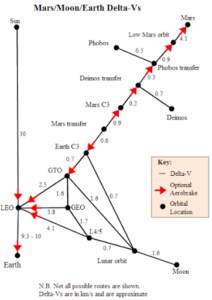Distributed surface networks can provide regional sensing, communications, position, navigation, and timing (PNT), and power distribution. However, it’s often not possible to install such networks with a delicate human touch. The Rapid Lunar Lander is a remotely-emplaced, hardened electronics package to service this need.
Special Operations forces routinely rely on networks of unattended ground sensors (UGS) to inform their systems in denied areas during covert operations. As a result, remote emplacement of these networks is essential. Moreover, rapid insertion of these networks largely eliminate aerodynamic deceleration (e.g., parachutes) as an option to facilitate a soft landing.
Similarly, evolving lunar sensing, communications, navigation, and power distribution networks will rely on networks of UGS to support manned and robotic endeavors. Due to the lack of atmosphere, remotely-emplaced lunar surface UGS will also not be able to rely on aerodynamic deceleration, but need to survive a landing onto the lunar regolith that covers almost the entire lunar surface. The regolith is generally from 4 to 5 m thick in mare areas and from 10 to 15 m in the older highland regions. The density of regolith at the Apollo 15 landing site averages approximately 1.35 g/cm3 for the top 30 cm, and it is approximately 1.85g/cm3 at a depth of 60 cm.


Spacecraft escape Earth when their propulsion system is able to provide sufficient acceleration (called delta-v) to lift them out of the Earth’s gravity well. That same propulsion system can insert them into a lunar orbit where they achieve a state of equilibrium within the Moon’s gravity well. NASA plans to place its Lunar Gateway into a specific one of these stable lunar orbits, called a Near Rectilinear Halo Orbit (NRHO). Similarly, the Air Force Research Lab Space Vehicles Directorate (AFRL/RV) plans to put another spacecraft, the Lunar Orbiting Base of Operations (LOBO), into that same orbit. LOBO will be carrying your landers! It is your challenge to use some combination of hardening and deceleration to place your landers on the lunar surface in a working state, where they can self-initialize and then self-organize into an IOT.
AFRL/RV: Chuck Finley, Lt Jake Lutz
NASA Ames Research Center: Bruce Yost
How are you planning to enable collaboration amongst multiple collaborators providing different parts of the solution?
We will be following the modular open system approach
Is there a desired band or frequency to use to connect sensors and/or communicate with the NRHO?
We would like to leverage existing antenna networks for command control and data back haul. Please identify how you would like to get data commanded.
Is there a list of desired sensors? i.e. What data is most interesting to capture?
What is the altitude and velocity above the Moon from which the lander will be released ? How far must it free fall?
The LOBO-1 spacecraft will be ferrying several spacecraft from Earth to Near Rectilinear Halo Orbit (NRHO). The current plan is to match the NASA Lunar Gateway NRHO, where the closest point to the surface will be 3,000km and the farthest will be 70,000km. The Lunar Landers will be stowed in a Lunar Lander dispenser during transit and until release. Every seven days, LOBO-1 will make its closest approach to the Moon. The proposed NRHO orbit would allow payloads dispensed from LOBO-1 to reach a low polar orbit with a delta-v of 730 m/s and a half a day of transit time. The approximate change in velocity (delta-v) from lunar orbit to arrive on the lunar surface with zero relative velocity is 1600 m/s (see below).
Or is the lander starting from a Lagrange point? If so, how will the initial impulse be provided to set the lander on a trajectory to intersect the lunar surface?
Lander is NOT starting from a Lagrange point. It is started from a point in NRHO specified by the dispensed system provider. The initial impulse to put the dispensed system on an intersecting trajectory will be provided by the Lunar Lander launcher onboard LOBO-1.
For example, can we assume that the lander will begin in an elliptical orbit where the apolune originates at the lagrange point and the perilune kisses or grazes the lunar surface?
Lander will begin in the above specified NRHO elliptical orbit and AFRL can potentially make the Lunar Lander dispenser provide an initial impulse sufficient to make the perilune graze the lunar surface.